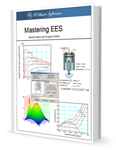Use of EES on Other Operating Systems
EES has been developed to run on 32-bit and 64-bit Windows operating systems, including Windows XP, Vista, 7/8 and 10. F-Chart Software does not officially support the use of EES on other operating systems. However, there are several options that allow use of EES on non-Windows operating systems. One option which is particularly applicable for universities is to use XenApp. XenApp allows EES to be made available on any device.
EES has been successfully installed on Macs that have the Intel chip that runs operating system 10.4.10 or newer. Also, EES can operate under Linux using Wine, an Open Source implementation of the Windows API. Instructions are provided below for both situations.
Running EES on the Macintosh
Modern Mac computers use an Intel-based processor that can run the Windows operating systems that EES is designed to run under. There are three ways to run EES under the Windows operating system on the Mac.
- Boot Camp
- Parallels Desktop
- VMWare Fusion
MacTech discusses the relative merits of each of these alternatives in their Vol 24, 2008 issue.
Alternatively, Windows programs can run on the Mac operating system by adding the WINE compatibility layer, as explained for Linux systems below. This alternative has the advantage of not requiring an additional operating system to be installed. Mac-specific WINE packages include:
- Crossover (free trial available)
- Wineskin wrapper (free)
- Darwine (free)
- Winebottler (free)
and others. These packages are able to install EES from the Setup_EES.exe file, or simply run EES from a folder where it has been pre-installed. It may be necessary to add the library file riched20.dll into the EES directory. (See item 4 below.)
Installing EES with Wine in Ubuntu
- Install the latest version of Wine
- Ubuntu 9.10: Use the software center and choose version 1.1.32 or later.
- Earlier versions: use the instructions provided here: http://www.winehq.org/download/deb
- Save the EES setup.exe file to any folder.
- Run the .exe file (Wine will start automatically). Do not select the 3D plotting option.
- It may be necessary to add the library file riched20.dll into the EES directory after the installation is completed. This file can be found in the WIndows\System32 directory on a computer that has the Windows operating system installed.
- If you experience a problem, try unchecking the option in the Preferences dialog to "Wrap long lines in the Equations window".
